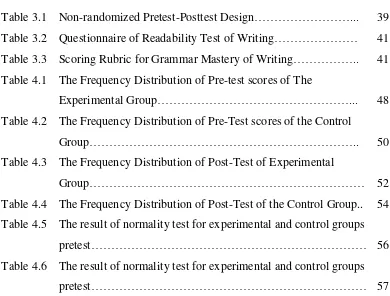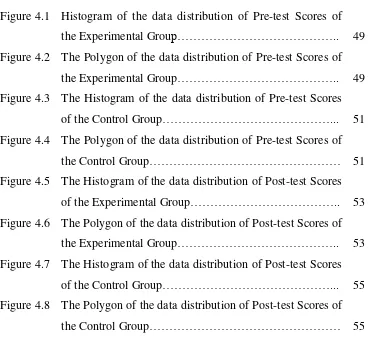THE EFFECTIVENESS OF AUDIOLINGUAL AND TASK-BASED
LEARNING METHODS IN TEACHING GRAMMAR OF WRITING
(A Quasi-Experimental Study at 7th Grade of a Public Junior High School in
Boyolali in The Academic Year of 2016/2017)
Thesis
A Thesis
Submitted as a Partial Fulfillment of the Requirements for Getting
Undergraduate Degree of Education of English Department
Ananda Rio Alif Pradana
K2210005
TEACHER TRAINING AND EDUCATION FACULTY
SEBELAS MARET UNIVERSITY
SURAKARTA
PRONOUNCEMENT
I would like to certify that the thesis entitled “The Effectiveness of Audiolingual and Task-Based Learning Methods in Teaching Grammar of
Writing (A Quasi-Experimental Study at 7th Grade of a Public Junior High
School in Boyolali in Academic Year of 2016/2017)” is really my own work. It is not a product of plagiarism or made by others. Everything related to others’ works is written in quotation, the sources of which are listed on the bibliography.
If then this pronouncement proves wrong, I am ready to receive any academic punishment.
Surakarta, 2017
APPROVAL OF THE CONSULTANTS
This thesis has been approved by the consultants to be examined by the Board of Thesis Examiners of the English Education Department of Teacher Training and Education Faculty of Sebelas Maret University Surakarta.
TITLE : The Effectiveness of Audiolingual and Task-Based Learning Methods in Teaching Grammar of Writing (A Quasi-experimental Study at 7th Grade of a Public Junior High School in Boyolali in The Academic Year of 2016/2017)
NAME : ANANDA RIO ALIF PRADANA NIM : K2210005
On :
Approved by:
Consultant 1 Consultant 2
Dr. Abdul Asib, M.Pd Kristiandi, S.S., M.A.
APPROVAL OF THE BOARD EXAMINERS
This thesis has been examined by the Board of the Examiners of Teacher Training and Education Faculty of Sebelas Maret University Surakarta and has been approved to fulfill one of the requirements for obtaining the Undergraduate Degree in English Education.
Day : Date :
Board of Examiners: Signatures: 1. Chairman
Teguh Sarosa, S.S., M.Hum.
NIP. 19730205 200604 1 001 (………) 2. Secretary
Ellisa Indriyani Putri Handayani, S.Pd., M.Hum
NIK. 19821222 20130201 (………)
3. Examiner 1
Dr. Abdul Asib, M.Pd
NIP. 19520307 198003 1 005 (………) 4. Examiner 2
Kristiandi, S.S., M. A.
NIP. 19770720 200112 1 001 (………)
Teacher Training and Education Faculty Sebelas Maret University
The Dean
ABSTRACT
The aims of this research are to investigate: (1) whether there is a significant difference in grammar mastery of writing between the students taught using audiolingual method and those taught using task-based learning; and (2) whether the students taught using audiolingual method have higher grammar mastery of writing than those taught using task-based learning. The research method used in this study is a quasi-experimental research design. This research was conducted at a Public Junior High School in Boyolali in the academic year of 2016/2017. The population of the research is the seventh grade of a Public Junior High School in Boyolali. The samples were class VII C as the experimental class which consists of 31 students and class VII A as the control class which consists of 31 students. The research instrument used to collect the data in this study is test. The data were analysed by using t-test formula. The computation of the t-test shows that t observation (to) = 2.447 is higher than t table (60, 0.05) = 1.960. Therefore, it can be concluded that there is a significant difference in grammar mastery of writing between students taught using Audiolingual Method and those taught using Task-Based Learning. The mean of the scores of the experimental group is 77.74, while the mean of the scores of the control group is 70.88. Therefore, it can be concluded that the students taught using Audiolingual Method have higher grammar mastery of writing than those taught using Task-Based Learning.
MOTTO
DEDICATION
This thesis is dedicated to:
My beloved Papa in Heaven
My beloved Mama
My younger brother
ACKNOWLEDGEMENT
Praise and thanks to Allah SWT, The Lord of Universe, who always blesses the writer in finishing his thesis as a partial requirement for getting the Undergraduate Degree of Education in English Department.
The writer would like to express his special gratitude for them who have given him their help, guidance, and support in writing this thesis.
1. Prof. Dr. Joko Nurkamto, M.Pd. as the Dean of Teacher Training and Education Faculty of Sebelas Maret University who approved this thesis. 2. Teguh Sarosa, S.S., M.Hum. as the head of English Education Department of
Teacher Training and Education Faculty.
3. Dr. Abdul Asib, M.Pd the first consultant, for the advice, patience, motivation, and correction in writing this thesis.
4. Kristiandi, S.S., M. A. the second consultant, for the advice, patience, motivation, and correction in writing this thesis.
5. Ellisa Indriyani Putri Handayani, S.Pd., M.Hum. the academic consultant, for the motivation, kindness, and advice.
6. All lecturers in English Education Department, for the valuable knowledge. 7. Mrs. Winarti Rahayu, S.Pd, the headmistress of SMP Negeri 2 Kemusu
Boyolali, for allowing the writer to conduct the research.
8. Mr. Dimas Haristian S.Pd, the English teacher for being a good partner and patiently helping the writer to do the research.
9. Mr. Ali Mashudi’s family who have sincerely helped the writer to do the research.
10.The students of VII C and VII A of SMP Negeri 2 Kemusu Boyolali who have sincerely helped the writer to do the research.
11.His mother, Sri Ratna Dekaningsih for her great love, unlimited patience, pray and support.
13.Estowara Manikam for being a good partner, motivating, accompanying and sharing in his every day.
14.His classmates, SBI 2010 (Etika, Rahma, Eska, Dona), for their motivation and care during learning together.
15.Fire Friends (Mitro, Cercet, Arpen, Bolot, Adam, Nggithut, Thothot, Kriwul, Nggesut, Gigih, Fariz) for their help, suggestions, laughing, cares and also for the happiness.
16.English Spartan (Moris, Sastro, Dhimsy, Apang, Tomek), for their help, suggestions, laughing, cares and also for the happiness.
17.KYT Sport & Entertainment (Kelik, Dolly, Badega, Aripin, Mas Budi, Simbah, Dipo, Sidney, Basir, Moyo, Irfan, Semper, Mundos, Konyil) for their help, laughing, cares, happiness and also for the craziness.
18.All of his friends in English Education Departments, for the supports and everlasting friendship.
The writer realizes that this thesis is still far from being perfect, so he accepts gratefully every comment and suggestion. Hopefully, this thesis will be useful for the readers and improvement of teaching English.
Surakarta, July 2017
TABLE OF CONTENTS
COVER ... i
PRONOUNCEMENT ... ii
APPROVAL OF THE CONSULTANTS ... iii
APPROVAL OF THE BOARD EXAMINERS ... iv
ABSTRACT ... v
MOTTO ... vi
DEDICATION ... vii
ACKNOWLEDGEMENT ... viii
TABLE OF CONTENTS ... x
LIST OF TABLES ... xiii
LIST OF FIGURES ... xiv
LIST OF APPENDICES ... xv
CHAPTER I ... 1
A. Background of the Study ... 1
B. Problem Identification ... 5
C. Problem Limitation ... 6
D. Problem Statement ... 6
E. The Objectives of The Study ... 6
F. Benefit of The Study ... 6
CHAPTER II ... 8
A. Review of Grammar ... 8
1. The Definition of Grammar ... 8
2. Parts of Grammar ... 9
3. Material of Grammar ... 10
4. Language Features of Descriptive Text ... 12
5. Grammar Mastery ... 13
B. Review of Writing ... 14
1. Definition of Writing ... 14
3. The Skills of Writing ... 15
4. Components of Writing ... 16
5. Teaching Writing as Foreign Language ... 17
C. Review of Task-Based Learning ... 18
1. The Concept of Task ... 18
2. The Definition of Task-Based Learning ... 22
3. The Characteristics of Task-Based Learning ... 22
4. Procedures of Task-Based Learning Method ... 23
5. Advantages and Disadvantages of Task-Based Learning Method ... 23
D. Review of Audiolingual Method ... 25
1. The Definition of Audiolingual Method ... 25
2. Audiolingual’s Techniques ... 27
3. The Characteristics of Audiolingual Method ... 30
4. Procedures of Audiolingual Method ... 30
5. Advantages and Disadvantages of Audiolingual Method ... 31
E. Review of Relevant Studies ... 32
F. Rationale ... 34
1. The Significance of The Difference between Audiolingual Method and Task-Based Learning ... 34
2. The Difference of Effectiveness between Audiolingual Method and Task-Based Learning ... 35
G. Hypothesis ... 36
CHAPTER III ... 38
A. The Method of The Research ... 38
B. The Setting of The Research ... 39
C. The Subject of The Research ... 39
D. The Technique of Collecting Data ... 40
E. The Technique of Analyzing The Data ... 43
CHAPTER IV ... 47
A. The Description of The Data ... 47
2. Post-test Score ... 51
B. Prerequisite Tests ... 55
1. Pre-test Scores ... 55
2. Post-test Scores ... 57
C. Hypothesis Testing ... 58
1. The First Hypothesis ... 58
2. The Second Hypothesis ... 59
D. Discussion ... 59
CHAPTER V ... 61
A. Conclusion ... 61
B. Implication ... 61
C. Suggestion ... 63
BIBLIOGRAPHY ... 64
LIST OF TABLES
Table 3.1 Non-randomized Pretest-Posttest Design………... 39 Table 3.2 Questionnaire of Readability Test of Writing……… 41 Table 3.3 Scoring Rubric for Grammar Mastery of Writing……….. 41 Table 4.1 The Frequency Distribution of Pre-test scores of The
Experimental Group………... 48 Table 4.2 The Frequency Distribution of Pre-Test scores of the Control
Group……….. 50
Table 4.3 The Frequency Distribution of Post-Test of Experimental
Group……… 52
Table 4.4 The Frequency Distribution of Post-Test of the Control Group.. 54 Table 4.5 The result of normality test for experimental and control groups
pretest……… 56
Table 4.6 The result of normality test for experimental and control groups
LIST OF FIGURES
Figure 4.1 Histogram of the data distribution of Pre-test Scores of the Experimental Group……….. 49 Figure 4.2 The Polygon of the data distribution of Pre-test Scores of
the Experimental Group……….. 49 Figure 4.3 The Histogram of the data distribution of Pre-test Scores
of the Control Group………... 51 Figure 4.4 The Polygon of the data distribution of Pre-test Scores of
the Control Group……… 51 Figure 4.5 The Histogram of the data distribution of Post-test Scores
of the Experimental Group……….. 53 Figure 4.6 The Polygon of the data distribution of Post-test Scores of
the Experimental Group……….. 53 Figure 4.7 The Histogram of the data distribution of Post-test Scores
of the Control Group………... 55 Figure 4.8 The Polygon of the data distribution of Post-test Scores of
LIST OF APPENDICES
Appendix 1 Lesson plan of the experimental group ... 68
Appendix 2 Lesson plan of the control group ... 115
Appendix 3 Writing test instruction ... 163
Appendix 4 Readability of writing test ... 165
Appendix 5 Result of readability of writing test ... 166
Appendix 6 Pre-test scores of experimental and control groups ... 168
Appendix 7 Descriptive statistics of experimental and control groups pre-test scores ... 170
Appendix 8 Normality test of pre-test of experimental and control groups ... 178
Appendix 9 Homogeneity test of pre-test of experimental and control groups 184 Appendix 10 Computation of t-test of pre-test of experimental and control groups ... 188
Appendix 11 Post-test scores of experimental and control groups ... 191
Appendix 12 Descriptive statistics of post-test scores of experimental and control groups ... 194
Appendix 13 Normality test of post-test of experimental and control groups .... 203
Appendix 14 Homogeneity test of post-test of experimental and control groups ... 209
Appendix 15 Computation of t-test of post-test of experimental and control groups ... 213
Appendix 16 Students’ answer sheet ... 216
Appendix 17 Standard normal distribution table ... 222
Appendix 18 Lilliefors table ... 223
Appendix 19 Chi-square distribution table ... 224
Appendix 20 t-distribution table ... 224
Appendix 21 Documentation ... 226

